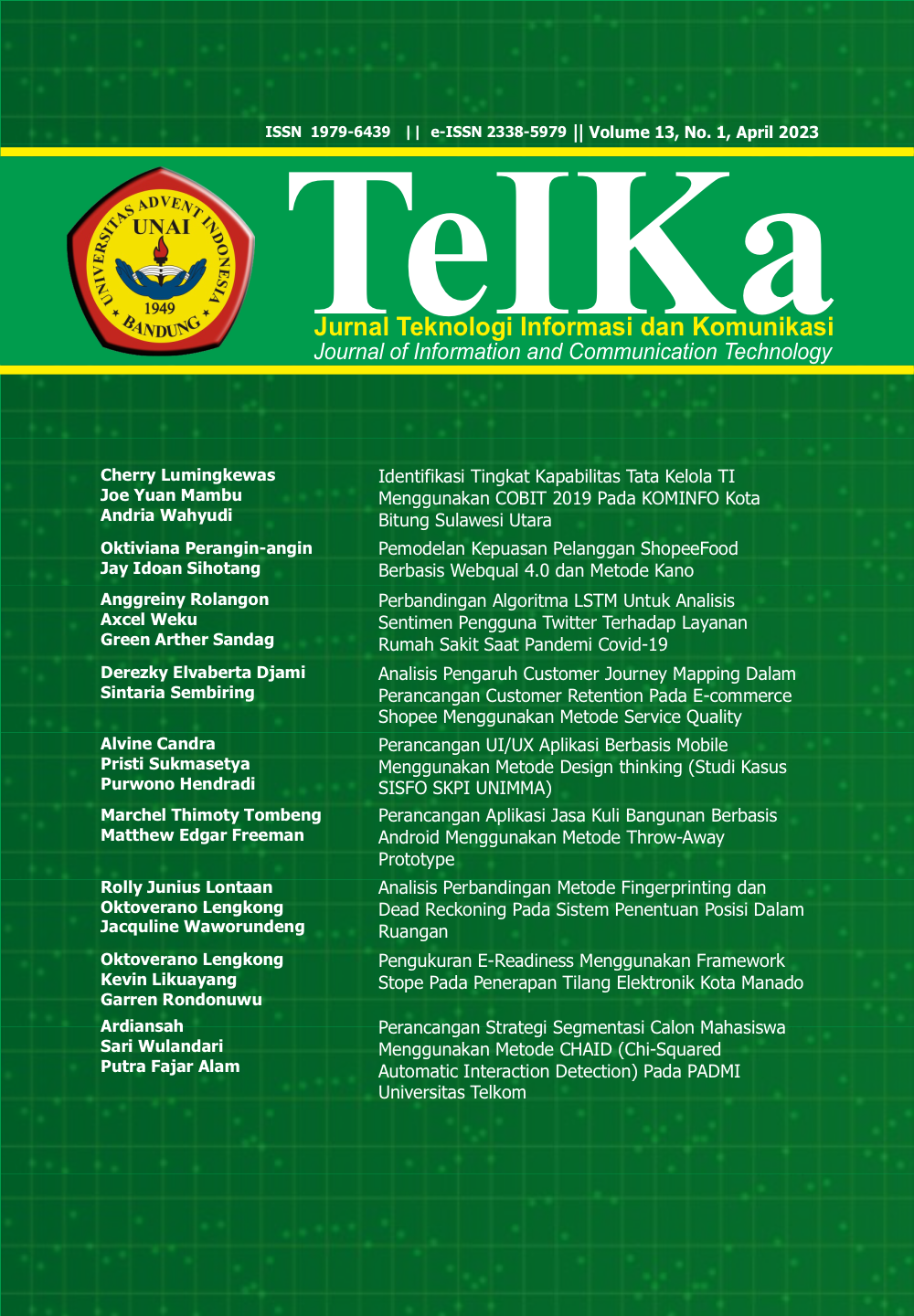The Comparison of LSTM Algorithms for Twitter User Sentiment Analysis on Hospital Services During the Covid-19 Pandemic
Keywords:
Twitter, LSTM, GRU, SimpleRNN, BiLTSMAbstract
Sentiment analysis has become a crucial aspect in understanding people’s opinions and emotions on various issues. In this study, we conducted sentiment analysis on tweets related to hospital services during the COVID-19 pandemic using LSTM, BiLSTM, GRU, and SimpleRNN models. The data collection process was carried out using the Twitter API and resulted in 15,093 tweets. The data preprocessing process includes data cleaning, case folding, tokenization, filtering, and stemming. The dataset was divided into 80% for training and 20% for testing. The results showed that the BiLSTM model had the highest accuracy of 86%, followed by the GRU model with an accuracy of 86%, the LSTM model with an accuracy of 85%, and the SimpleRNN model with an accuracy of 75%. The BiLSTM model also had the highest MCC of 71%. The study concludes that the BiLSTM model outperformed other models in predicting the sentiment of tweets related to hospital services during the COVID-19 pandemic. This study’s findings may have significant implications for healthcare providers in enhancing their services’ quality and improving patients’ satisfaction during pandemics.
Downloads
References
H. Leite, C. Lindsay, and M. Kumar, “COVID-19 outbreak: implications on healthcare operations,” TQM J., vol. 33, no. 1, pp. 247–256, 2021, doi: 10.1108/TQM-05-2020-0111.
S. R. Razu et al., “Challenges Faced by Healthcare Professionals During the COVID-19 Pandemic: A Qualitative Inquiry From Bangladesh,” Front. Public Heal., vol. 9, no. August, 2021, doi: 10.3389/fpubh.2021.647315.
AHA, “Data Brief: Health Care Workforce Challenges Threaten Hospitals’ Ability to Care for Patients,” Am. Hosp. Assoc., no. August, pp. 2020–2021, 2022, [Online]. Available: https://www.aha.org/system/files/media/file/2021/11/data-brief-health-care-workforce-challenges-threaten-hospitals-ability-to-care-for-patients.pdf.
R. Saptari, Rianto, and A. I. Gufroni, “Analisis Sentimen Pengguna Twitter Terhadap Pelayanan Unit Gawat Darurat Rumah Sakit Umum di Indonesia Menggunakan Seleksi Fitur Information Gain dan Support Vector Machine,” Journal Oof Informatics Education, vol. XX. pp. 104–110, 2018, [Online]. Available: http://e-journal.ivet.ac.id/index.php/jiptika/article/view/1925/1369.
R. C. Staudemeyer and E. R. Morris, “Understanding LSTM -- a tutorial into Long Short-Term Memory Recurrent Neural Networks,” pp. 1–42, 2019, [Online]. Available: http://arxiv.org/abs/1909.09586.
S. Agrawal, S. K. Jain, S. Sharma, and A. Khatri, “COVID-19 Public Opinion: A Twitter Healthcare Data Processing Using Machine Learning Methodologies,” Int. J. Environ. Res. Public Health, vol. 20, no. 1, 2023, doi: 10.3390/ijerph20010432.
G. A. Sandag, A. M. Manueke, and M. Walean, “Sentiment Analysis of COVID-19 Vaccine Tweets in Indonesia Using Recurrent Neural Network (RNN) Approach,” 3rd Int. Conf. Cybern. Intell. Syst. ICORIS 2021, 2021, doi: 10.1109/ICORIS52787.2021.9649648.
J. D. C. Aruan, B. Rahyudi, and A. Ridok, “Analisis Sentimen Opini Masyarakat terhadap Pelayanan Rumah Sakit Umum Daerah menggunakan Metode Support Vector Machine dan Term Frequency – Inverse Document Frequency,” Jurnal Pengembangan Teknologi Informasi dan Ilmu Komputer, vol. 6, no. 5. pp. 2072–2078, 2022.
A. P. Rodrigues et al., “Real-Time Twitter Spam Detection and Sentiment Analysis using Machine Learning and Deep Learning Techniques,” Comput. Intell. Neurosci., vol. 2022, 2022, doi: 10.1155/2022/5211949.
S. Hochreiter and J. Schmidhuber, “Long Short-Term Memory,” Neural Comput., vol. 9, no. 8, pp. 1735–1780, 1997, doi: 10.1162/neco.1997.9.8.1735.
I. Goodfellow, Y. Bengio, and A. Courville, “Book: Deep Learning,” Prmu, pp. 1–10, 2016, [Online]. Available: www.deeplearningbook.org.
S. Minaee, E. Azimi, and A. Abdolrashidi, “Deep-Sentiment: Sentiment Analysis Using Ensemble of CNN and Bi-LSTM Models,” 2019, [Online]. Available: http://arxiv.org/abs/1904.04206.
M. Rhanoui, M. Mikram, S. Yousfi, and S. Barzali, “A CNN-BiLSTM Model for Document-Level Sentiment Analysis,” Mach. Learn. Knowl. Extr., vol. 1, no. 3, pp. 832–847, 2019, doi: 10.3390/make1030048.
K. Cho et al., “Learning phrase representations using RNN encoder-decoder for statistical machine translation,” EMNLP 2014 - 2014 Conf. Empir. Methods Nat. Lang. Process. Proc. Conf., pp. 1724–1734, 2014, doi: 10.3115/v1/d14-1179.
J. Chung, C. Gulcehre, K. Cho, and Y. Bengio, “Empirical Evaluation of Gated Recurrent Neural Networks on Sequence Modeling,” pp. 1–9, 2014, [Online]. Available: http://arxiv.org/abs/1412.3555.
R. Ni and H. Cao, “Sentiment Analysis based on GloVe and LSTM-GRU,” Chinese Control Conf. CCC, vol. 2020-July, pp. 7492–7497, 2020, doi: 10.23919/CCC50068.2020.9188578.
M. B. Silva, Percepção da população assistida sobre a inserção de estudantes de medicina na Unidade Básica de Saúde, First Edit., vol. 1, no. 9. O’Reilly Media, 2016.
F. Koto and G. Y. Rahmaningtyas, “Inset lexicon: Evaluation of a word list for Indonesian sentiment analysis in microblogs,” Proc. 2017 Int. Conf. Asian Lang. Process. IALP 2017, vol. 2018-Janua, no. December, pp. 391–394, 2018, doi: 10.1109/IALP.2017.8300625.
Downloads
Published
How to Cite
Issue
Section
License
Copyright (c) 2023 TeIKa

This work is licensed under a Creative Commons Attribution-ShareAlike 4.0 International License.
The submitting author warrants that the submission is original and that she/he is the author of the submission together with the named co-authors; to the extend the submission incorporates text passages, figures, data or other material from the work of others, the submitting author has obtained any necessary permission.
Articles in this journal are published under the Creative Commons Share Alike Attribution Licence (CC-BY-SA What does this mean?). This is to get more legal certainty about what readers can do with published articles, and thus a wider dissemination and archiving, which in turn makes publishing with this journal more valuable for you, the authors.
By submitting an article the author grants to this journal the non-exclusive right to publish it. The author retains the copyright and the publishing rights for his article without any restrictions.










